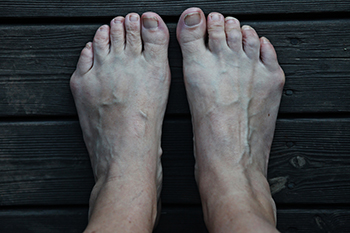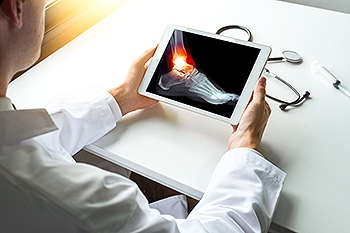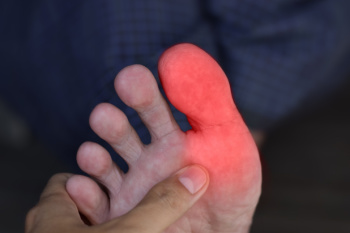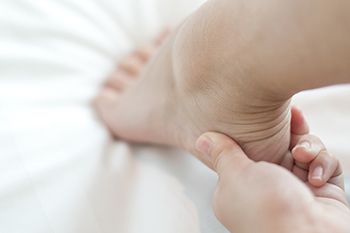Connect With Us
Blog
Items filtered by date: December 2024
Small Bump With a Big Impact

A tailor’s bunion, or bunionette, is a bony bump that forms on the foot near the base of the little toe. It occurs when the fifth metatarsal bone shifts outward, causing the joint to protrude. This condition often leads to pain, redness, and swelling especially when wearing tight shoes. Contributing factors include genetics, foot structure, and wearing ill-fitting footwear. People with flat feet or high arches are more prone to developing them. Diagnosis involves a physical exam and possibly X-rays to assess severity. Relief includes wearing wider shoes, padding the area, or using custom orthotics. Severe cases may require surgery to realign the bone. If you have a bunionette, it is suggested that you schedule an appointment with a chiropodist for appropriate relief options.
Bunions progressively worsen over time and may cause walking in your shoes to become difficult. To learn more about bunions, please consult with one of our chiropodists from West Toronto Foot & Ankle Clinic Inc. . Our chiropodist will assess your condition and provide you with quality foot and ankle treatment.
What Are Bunions?
A bunion is a bony bump that protrudes from the base of the big toe. Bunions are caused due to a misalignment of the first metatarsal. The characteristic bump of a bunion forms when the metatarsal shifts outwards from its proper position. Bunions develop slowly over time and progressively worsen without treatment. The skin over the bunion may develop calluses due to the friction from shoes. Eventually, a bunion can make walking uncomfortable or even painful. Bunions are one of the most common foot deformities and are especially common in women and older adults.
Symptoms
A bunion appears as a bulging bump on the outside of the base of the big toe.
The bunion may also:
- Be swollen, red, or sore
- Develop corns or calluses over it
- Cause pain
- Limit the big toe’s range of motion
Treatment
There are several different treatments available for bunions. Conservative treatment options include wearing shoes with a wider toe box, cushioning the bunion with a specialized pad, wearing shoe inserts, icing the bunion if it becomes inflamed, and taking medications to relieve pain. In more severe cases, more invasive procedures may be done. This may involve removing the swollen tissue around the bunion, straightening the big toe, realigning the bones at the front of the foot, or a combination of these procedures.
If you have any questions, please feel free to contact our office located in . We offer the newest diagnostic and treatment technologies for all your foot care needs
Common Running Injuries

Running is a popular activity that provides numerous health benefits, but it also puts significant strain on the feet and ankles. Common running injuries include plantar fasciitis, Achilles tendinopathy, ankle sprains, and stress fractures. Plantar fasciitis involves inflammation of the ligament on the sole, called the plantar fascia. It causes sharp pain in the heel, particularly after periods of rest. Achilles tendinopathy often results from increased training intensity, leading to pain and stiffness above the back of the heel. Ankle sprains occur when ligaments are overstretched or torn, typically from a sudden twist, leading to immediate pain and swelling. Stress fractures, caused by repetitive pressure, involve small cracks in bones such as the metatarsals or heel bone, resulting in pain that worsens with activity. A chiropodist can assess and diagnose these conditions, recommend personalized treatment plans, and provide advice to prevent future running injuries. If you have hurt your foot or ankle while running, it is suggested that you schedule an appointment with a chiropodist.
Although running is a wonderful exercise to keep you in shape, it can wreak havoc on your feet and ankles if you don’t take preventive measures. If you have sustained a foot and ankle injury from running, please consult with one of our chiropodists from West Toronto Foot & Ankle Clinic Inc. . Our chiropodist can help you maintain the health of your lower limbs and your mobility.
Some common running injuries include:
- Achilles tendonitis
- Shin splints
- Ankle sprains
- Stress fractures
- Plantar fasciitis
- Bursitis
What causes injuries?
These injuries are usually caused by overtraining, wearing the wrong shoes, running on hard surfaces, having tight and inflexible muscles, or having biomechanical issues in the feet or ankles.
What can I do to prevent injuries?
- Train slowly and gradually
- Give yourself plenty of time to recover following a run
- Wear shoes that fit properly and support your foot
- Avoid running on hard surfaces, like concrete
- Stretch and strengthen the muscles of your lower legs
- Warm-up prior to a run
- Have your gait analyzed and your feet examined by a chiropodist to determine if there are any biomechanical problems that need to be treated
If you have any questions, please feel free to contact our office located in . We offer the newest diagnostic and treatment technologies for all your foot care needs.
Recognizing the Symptoms of a Broken Ankle

A broken ankle can cause several noticeable symptoms that require immediate attention. One of the first signs is bruising surrounding the ankle area, which may appear soon after the injury. Joint deformity, such as an unusual angle or position of the foot, can also be a clear indicator of a fracture. Swelling is common and can make the ankle appear larger than normal, often accompanied by significant pain, especially when trying to move the foot or put pressure on it. One of the most concerning symptoms is the inability to bear weight on the affected foot, as the pain becomes too intense. The causes of a broken ankle typically include falls, sports injuries, or accidents, which lead to the bones in the ankle becoming fractured or dislocated. If you have broken your ankle, it is suggested that you consult a chiropodist for an exam and treatment options.
Ankle fractures are serious injuries that require medical attention. If you have broken your ankle, please consult with one of our chiropodists from West Toronto Foot & Ankle Clinic Inc. . Our chiropodist can help you maintain the health of your lower limbs and your mobility.
Symptoms
- Pain at the site of the fracture
- Swelling
- Bruising
- Blisters
- Inability to walk
- Ankle deformity
- In the case of an open fracture, bone protruding through the skin
Diagnosis
- Physical examination
- Medical history
- X-ray, bone scan, or other imaging study
Treatments
- Rest
- Ice
- Compression
- Elevation
- Immobilization
- Pain medications
- Surgery
If you have any questions, please feel free to contact our office located in . We offer the newest diagnostic and treatment technologies for all your foot care needs.
Big Toe Pain May Be Hallux Rigidus

Hallux rigidus is a form of arthritis that affects the joint at the base of the big toe, leading to stiffness and limited movement. Over time, the cartilage in this joint deteriorates, making it painful to bend the toe. This condition typically develops due to wear and tear, injury, or genetic predisposition, and can significantly impact mobility. Symptoms of hallux rigidus include pain and swelling surrounding the big toe, especially during activities like walking and standing. Over time, the pain may become more constant and the toe joint can become stiff making it difficult to wear certain shoes. Bone spurs may also form causing additional discomfort. If left untreated, hallux rigidus can worsen and limit daily activities. If you have big toe pain, it is suggested that you schedule an appointment with a chiropodist for a proper diagnosis and treatment.
Osteoarthritis in the feet or ankles can be a painful and disabling condition that may interfere with your daily activities. If you have arthritis, please consult with one of our chiropodists from West Toronto Foot & Ankle Clinic Inc. . Our chiropodist will assess your condition and provide you with quality foot and ankle treatment.
What Is Osteoarthritis?
Osteoarthritis is a condition in which the protective layer of cartilage in the joints breaks down over time. This loss of cartilage causes the bones to rub together during movement, leading to pain and inflammation. Osteoarthritis is associated with aging, and often affects the small joints of the feet and ankles.
Symptoms
Symptoms of osteoarthritis include:
- Joint pain
- Joint stiffness
- Swelling in or around the joint
- Restricted range of motion
- Difficulty walking
Diagnosis
Osteoarthritis can be diagnosed through physical examination. You may also need to have an X-ray taken to assess the extent of the damage caused by arthritis.
Treatment
Treatment for osteoarthritis focuses on reducing symptoms and improving the function of the affected joints. Conservative treatments include oral pain medications, orthotic devices, bracing or immobilizing the affected foot or ankle, steroid injections into the affected joint to reduce inflammation, and physical therapy. In more severe cases, surgery may be necessary.
If you have any questions, please feel free to contact our office located in . We offer the newest diagnostic and treatment technologies for all your foot care needs
It's Time for Beautiful Feet
Causes and Relief for Foot and Heel Pain in Children

Children can experience foot and heel pain for various reasons, often causing discomfort that affects their daily activities. One common cause is growth plate inflammation, known as Sever's disease, which typically occurs during periods of rapid growth. Another factor is flat feet or improper foot alignment, leading to increased strain on muscles and ligaments. Symptoms may include localized pain, tenderness, and difficulty walking or running. To provide relief, it is essential to encourage rest and reduce activities that contribute to pain. Stretching exercises can improve flexibility and strength, and wearing proper footwear, including supportive shoes or orthotics, can also make a significant difference. If your child has foot or heel pain, it is suggested that you contact a chiropodist who can offer effective treatment solutions.
If your child is experiencing foot or ankle pain, please consult with one of our chiropodists from West Toronto Foot & Ankle Clinic Inc. . Our chiropodist will assess your condition and provide you with quality foot and ankle treatment.
Common Causes of Foot Pain in Children
While children can experience many of the same foot problems as adults do, some foot problems may be more common during childhood.
Causes of foot pain in children can include:
- Deformities that are present from birth, such as flat feet or clubfoot
- Sever’s disease, which is an inflammation of the growth plate in the heel bone
- Various sports injuries, such as sprains and fractures
- Ingrown toenails
- Athlete’s foot
- Plantar warts
Prevention
It is important to look after the health of children’s feet in order to prevent future problems from arising. Keep your child’s feet clean and dry, trim their toenails regularly, ensure their shoes fit properly, and keep a watchful eye on any symptoms of foot pain, such as limping. If you notice any symptoms or if your child complains of foot pain, a chiropodist can help.
If you have any questions, please feel free to contact our office located in . We offer the newest diagnostic and treatment technologies for all your foot care needs.
Blog Archives
- October 2025
- September 2025
- August 2025
- July 2025
- June 2025
- May 2025
- April 2025
- March 2025
- February 2025
- January 2025
- December 2024
- November 2024
- October 2024
- September 2024
- August 2024
- July 2024
- June 2024
- May 2024
- April 2024
- March 2024
- February 2024
- January 2024
- December 2023
- November 2023
- October 2023
- September 2023
- August 2023
- July 2023
- June 2023
- May 2023
- April 2023
- March 2023
- February 2023
- January 2023
- December 2022
- November 2022
- October 2022
- September 2022
- August 2022
- July 2022
- June 2022
- May 2022
- April 2022
- March 2022
- February 2022
- January 2022
- December 2021
- November 2021
- October 2021
- September 2021
- August 2021
- July 2021
- June 2021
- May 2021
- April 2021
- February 2021
- January 2021

